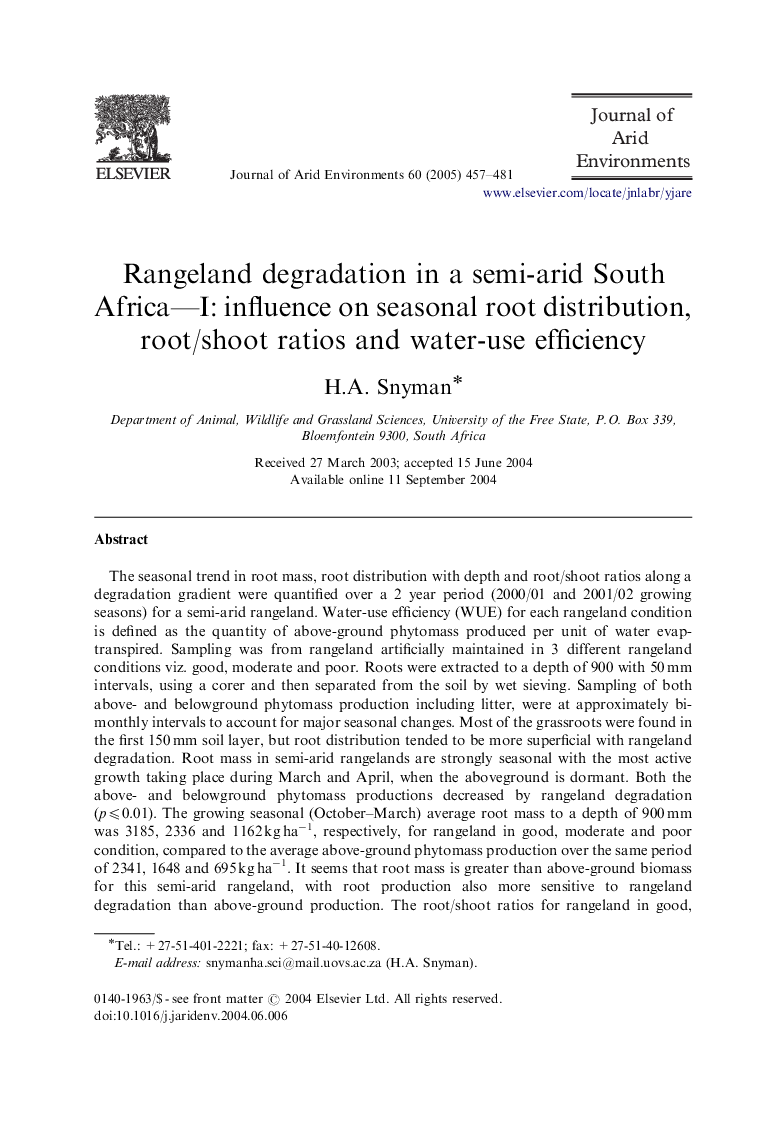| Article ID | Journal | Published Year | Pages | File Type |
|---|---|---|---|---|
| 9447963 | Journal of Arid Environments | 2005 | 25 Pages |
Abstract
The seasonal trend in root mass, root distribution with depth and root/shoot ratios along a degradation gradient were quantified over a 2 year period (2000/01 and 2001/02 growing seasons) for a semi-arid rangeland. Water-use efficiency (WUE) for each rangeland condition is defined as the quantity of above-ground phytomass produced per unit of water evap-transpired. Sampling was from rangeland artificially maintained in 3 different rangeland conditions viz. good, moderate and poor. Roots were extracted to a depth of 900 with 50 mm intervals, using a corer and then separated from the soil by wet sieving. Sampling of both above- and belowground phytomass production including litter, were at approximately bi-monthly intervals to account for major seasonal changes. Most of the grassroots were found in the first 150 mm soil layer, but root distribution tended to be more superficial with rangeland degradation. Root mass in semi-arid rangelands are strongly seasonal with the most active growth taking place during March and April, when the aboveground is dormant. Both the above- and belowground phytomass productions decreased by rangeland degradation (p⩽0.01). The growing seasonal (October-March) average root mass to a depth of 900 mm was 3185, 2336 and 1162 kg haâ1, respectively, for rangeland in good, moderate and poor condition, compared to the average above-ground phytomass production over the same period of 2341, 1648 and 695 kg haâ1. It seems that root mass is greater than above-ground biomass for this semi-arid rangeland, with root production also more sensitive to rangeland degradation than above-ground production. The root/shoot ratios for rangeland in good, moderate and poor conditions ranged between 1.57-3.20, 1.65-3.46 and 2.06-7.14, respectively. Water-use efficiency declined (p⩽0.01) with rangeland degradation. Rangeland in good condition averaged a WUE of 2.97 kg above-ground phytomass produced haâ1 mmâ1 evapo-transpiration. The average litter productions were 99.55, 61.51 and 24.00 kg haâ1, respectively, for rangeland in good, moderate and poor condition. As a proportion of annual phytomass production, litterfall of 5.35% for rangeland in good condition was obtained. This study is one of few root studies available where different rangeland conditions were evaluated and can serve as guidelines for sustainable utilization of the rangeland ecosystem in semi-arid climate.
Related Topics
Physical Sciences and Engineering
Earth and Planetary Sciences
Earth-Surface Processes
Authors
H.A. Snyman,
